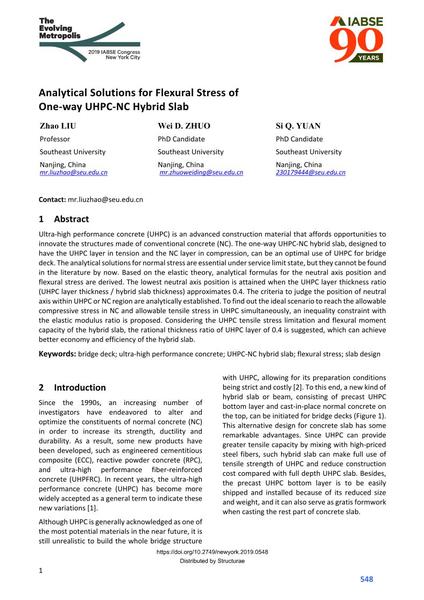Analytical Solutions for Flexural Stress of One-way UHPC-NC Hybrid Slab

|
|
|||||||||||
Bibliographic Details
| Author(s): |
Zhao Liu
(Southeast University)
Wei D. Zhuo (Southeast University) Si Q. Yuan (Southeast University) |
||||
|---|---|---|---|---|---|
| Medium: | conference paper | ||||
| Language(s): | English | ||||
| Conference: | IABSE Congress: The Evolving Metropolis, New York, NY, USA, 4-6 September 2019 | ||||
| Published in: | The Evolving Metropolis | ||||
|
|||||
| Page(s): | 548-554 | ||||
| Total no. of pages: | 7 | ||||
| DOI: | 10.2749/newyork.2019.0548 | ||||
| Abstract: |
Ultra‐high performance concrete (UHPC) is an advanced construction material that affords opportunities to innovate the structures made of conventional concrete (NC). The one‐way UHPC‐NC hybrid slab, designed to have the UHPC layer in tension and the NC layer in compression, can be an optimal use of UHPC for bridge deck. The analytical solutions for normal stress are essential under service limit state, but they cannot be found in the literature by now. Based on the elastic theory, analytical formulas for the neutral axis position and flexural stress are derived. The lowest neutral axis position is attained when the UHPC layer thickness ratio (UHPC layer thickness / hybrid slab thickness) approximates 0.4. The criteria to judge the position of neutral axis within UHPC or NC region are analytically established. To find out the ideal scenario to reach the allowable compressive stress in NC and allowable tensile stress in UHPC simultaneously, an inequality constraint with the elastic modulus ratio is proposed. Considering the UHPC tensile stress limitation and flexural moment capacity of the hybrid slab, the rational thickness ratio of UHPC layer of 0.4 is suggested, which can achieve better economy and efficiency of the hybrid slab. |
||||
| Keywords: |
bridge deck ultra‐high performance concrete UHPC‐NC hybrid slab flexural stress slab design
|
||||
